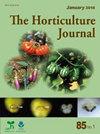Prediction of Soluble Solids of Tomato Fruit Grown in Salinized Nutrient Solution Based on the Electrical Conductivity of the Drainage
IF 1.2
4区 农林科学
Q4 HORTICULTURE
引用次数: 1
Abstract
The relationship between fruit Brix and the electrical conductivity (EC) of the nutrient solution was investigated under gradually increasing EC conditions to predict and control tomato fruit Brix in commercial greenhouses in Japan. Based on the three experiments, fruit Brix was significantly and highly correlated with the cumulative EC of the drainage during the period from anthesis to harvest (cECd). This relationship followed a linear regression function. We then modelled fruit Brix based on cECd and validated this model to predict and control fruit Brix in four other experiments in different growing seasons using two cultivars, slab substrates, and irrigation systems. Using this model, we calculated the target cECd (cECdt) to achieve a target fruit Brix of 6% or higher and used cECdt as an indicator to manipulate the EC of the nutrient solution. In the validation experiments, cECd was lower than cECdt at the beginning of harvest in all experiments. cECd reached cECdt at 72.3–214.0°C·day after the first harvest. When cECd was higher than cECdt, more than 86.9% of the fruit had a higher than Brix 6%. In addition, the marketable yield was higher than 88.2%. RMSEs between the observed fruit Brix and predicted fruit Brix were 0.60–1.25. These results indicate that our model can predict and control fruit Brix.基于排水电导率的盐碱化营养液中番茄果实可溶性固形物预测
为了预测和控制日本商业大棚番茄果实白度,在逐渐增加电导率的条件下,研究了营养液中果实白度与电导率的关系。结果表明,果实白锐度与开花至收获期排水累积EC (cECd)呈极显著高度相关。这种关系遵循线性回归函数。然后,我们基于cECd建立了果实白度模型,并在另外四个不同生长季节的试验中验证了该模型对果实白度的预测和控制,这些试验使用了两个品种、平板基质和灌溉系统。利用该模型,我们计算了目标cECd (cECdt),以实现目标果实白锐度达到6%或更高,并以cECdt作为指标来操纵营养液的EC。在验证实验中,所有实验的cECd均低于采收开始时的cECdt。第一次收获后72.3 ~ 214.0°C·d, cECd达到cECdt。当cECd高于cECdt时,86.9%以上的果实Brix高于cECdt 6%。此外,市场收益率高于88.2%。实测果实糖度与预测果实糖度的rmse为0.60 ~ 1.25。结果表明,该模型可以有效地预测和控制果实白度。
本文章由计算机程序翻译,如有差异,请以英文原文为准。
求助全文
约1分钟内获得全文
求助全文
来源期刊

Horticulture Journal
HORTICULTURE-
CiteScore
2.20
自引率
8.30%
发文量
61
期刊介绍:
The Horticulture Journal (Hort. J.), which has been renamed from the Journal of the Japanese Society for Horticultural Science (JJSHS) since 2015, has been published with the primary objective of enhancing access to research information offered by the Japanese Society for Horticultural Science, which was founded for the purpose of advancing research and technology related to the production, distribution, and processing of horticultural crops. Since the first issue of JJSHS in 1925, Hort. J./JJSHS has been central to the publication of study results from researchers of an extensive range of horticultural crops, including fruit trees, vegetables, and ornamental plants. The journal is highly regarded overseas as well, and is ranked equally with journals of European and American horticultural societies.
 求助内容:
求助内容: 应助结果提醒方式:
应助结果提醒方式:


